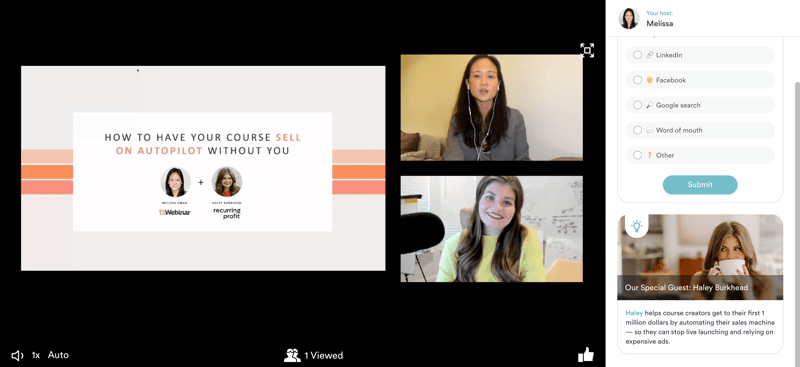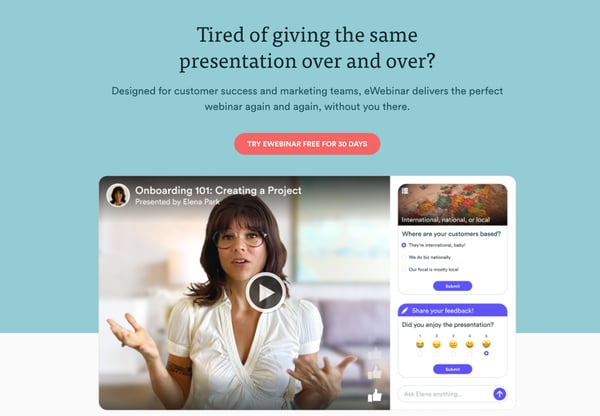How to Make Money Selling Courses Without Lowering Your Price
by Todd Parmley
COO, eWebinar
Last updated July 16, 2021
Warning: don’t lower the price of your course until you read this!
Not generating the amount of course sales you want can be frustrating, especially when you’ve been trying to sell your online course for some time. If you’ve started blaming yourself — and have even thought about changing your online course pricing — you should know that your online course pricing strategy isn’t the problem. The real issue is how you’ve been trying to make money selling courses online and where you’ve been spending your resources.
Creating a valuable course is the easy part. This article is about how to make money selling courses, and covers these key topics:
- How much can you make selling online courses?
- How to make more money selling courses: top 8 tips for scaling course sales
- 6 slimy sales tactics you should never use if you want to make money selling online courses
- How to sell your course while you sleep: using an automated not live webinar demo
So how much can you make selling online courses? We’ll get into this first before exploring how to make money selling online courses.
How much can you make selling online courses?
Most course creators are able to earn between $1K to $5K per month, while the most successful creators earn $10K to $50K per month. Selling online courses can bring in anywhere between $0 to $50K a month, depending on the level of effort put towards marketing and sales. Over time, course creators have scaled their business to make well over $1M in sales every year.
PRO TIP: For a real-life example of how much you can make selling online courses, sign up for this webinar on how Haley Burkhead got to her first $1 Million in 16 months by automating her course sales.
By implementing the strategies covered below, you can start consistently earning more from your course sales with less resources needed.
How to make more money selling courses: top 8 tips for scaling course sales
If you feel like you’re doing a lot of work selling and maintaining your course and not seeing a lot of results, it’s time to plan ways to scale your sales. Here are some top tips on how to make money selling courses online.
1. Fill your sales funnel with the right people
As tempting as it might be to buy a lot of ads to market your course to anyone and everyone, you don’t want to do this. Chances are when you created your course, you had a target audience in mind.
You want to focus your efforts on filling your funnel with those who will benefit most from taking your course. Before you spend a bunch of money on ads, look for online places where you can find those people, establish your credibility, promote your course, and generate free leads. Examples include Facebook groups, Reddit forums, and LinkedIn communities.
If you want some inspiration on how to generate new leads, check out this webinar on how to promote and sell your course with organic content.
2. Leverage your existing audience

Image Credit: Mailchimp.com
While you might feel like you need to focus only on reaching new people, don’t forget about those you’ve already established a connection with. If someone has chosen to follow you or give you their contact information in the past, it means they are interested in what you offer. Nurture those relationships with your social media and email marketing until they are ready to buy your course.
And don’t forget about former customers who have taken your course in the past. Having already worked with you, they’ve witnessed your credibility and the quality of your offerings. Creating follow up courses specifically designed for former students is a great way to grow your business.
3. Don’t do live sales

Despite live webinars being a popular and effective method of selling online courses, the truth is that they require more resources than they’re worth. Instead, you should opt to create an automated webinar that will run on a recurring schedule without you needing to be present. This will allow you to reach more people at times when it’s most convenient for them, and let you focus more of your energy on growing your business.
Automated webinars are just as effective as live webinars when it comes to conversion — but they require much less effort to maintain over time.
Want to learn more about using an automated webinar to promote your course? Register for this webinar on how to sell your course on autopilot.
4. Find ways to clone yourself

Image Credit: Later.com
Do you feel overwhelmed with the amount of work you need to do for your business? Before you start posting job ads, you should know that there are ways to clone yourself. More specifically, there are ways to automate a lot of your tasks and processes at little to no cost.
Planning ways to remove yourself from menial and/or repetitive tasks will give you a lot of your time back and increase your sales without you needing to hire support staff. Examples include creating pre-written email responses, using a chat bot program or tools like Dialpad for customer service, and scheduling posts using marketing platforms.
For great tools for selling your course better, check out the best tools for course creators.
5. Go deep, not wide with your audience

Image Credit: Recurring Profit
Many people believe that more products means more sales, but this doesn’t ring true for online courses. You could offer many different courses, but nothing will sell if they don’t offer a quality experience.
Start by prioritizing one course and focus on how you can expand on its lessons and offerings. It’s so much more important to ‘go deep’ with your audience and make your course more niche, more unique, and more specialized so that it’s really fulfilling the promises it makes.
It’s often our instinct to think that a more general course means more people will be interested, which will result in more sales, when in fact, the exact opposite is true. More general means less people believe it has value for them, which will result in less sales.
6. Don’t be afraid to spend money on the things that matter
It can be easy to fall into the trap of believing it’s better to do everything the cheapest way possible, especially early on in your business. This can sometimes be the most expensive mistake you’ll make as a course creator.
Use the right tools to help you scale, increase your subscription to a tool you’re already using if it will make the difference, hire a designer on Upwork if it will save you tons of time, or get an assistant for the day-to-day so you can focus on the things that matter.
7. Don’t follow the ‘industry standard’ when it comes to pricing and timeline
When choosing a time it takes to complete the course, and attaching a price tag to that, there is no ‘industry standard,’ and trying to follow what others are doing is only going to result in you underpricing your course and dragging out the timeline.
Don’t model based on what everyone else is doing and instead, choose the timeframe that makes sense based on your course structure and the outcomes. If your roadmap only takes 6 weeks to follow, then the course should be six weeks long; you don’t need to set the timeline at one year just because you think the price is too high.
8. Resist the temptation to lower your price
When your course isn’t selling as well as you’d hoped, it can be easy to discredit your work and convince yourself to lower the bottom line when pricing your online course. Doing this is actually a sure way to keep you from growing your sales.
The price of your course is based on the perceived transformation your course will create in people. You don’t want to devalue all your hard work by dropping the price, because that’s really unlikely to increase your sales, and in fact, is more likely to decrease the number of people who are interested in it because they think it will not have a dramatic impact on their life.
“When we start program-padding, as I like to call it, we're basically just trying to make it worth the price. So we think that we need to add 12 bullet points worth of support and bonuses. And that's not always the case. The price is based on the value of the transformation, not based on the value of the bonuses.” - Kyshira Moffett
Many of these pricing tips have come from our conversation with Kyshira Moffet — a tried and true business coach for course creators. Make sure you check out the full webinar: How to Scale a High-Ticket Coaching Program with Automated Webinars. Or check out more nuggets of wisdom from Kyshira in our article containing the top quotes and strategies from successful course creators.
6 slimy sales tactics you should never use if you want to make money selling online courses
Like all types of sales, there are things you should and shouldn’t do, and doing some of these things could actually hurt your chances of ever hitting your financial goals. These are some of the worst sales tactics course creators should avoid:
- Don’t use scare tactics - Intimidating people to enroll can create a negative perception of your character and course. Don’t say things like “Not taking this course is going to cost you thousands of dollars!!!” People don’t respond well to those kinds of tactics.
- Don’t be deceitful - Making claims about your course that aren’t true can completely damage your credibility, which is something you won’t be able to recover from.
- Don’t be inauthentic - Pretending you’re someone you’re not can make potential students lose trust in you as an instructor.
- Don’t insult potential students - Customers want to work with instructors that motivate, not ones that call out their mistakes in ways that are not constructive.
- Don’t expect people to just ‘believe’ everything you say - Offer concrete examples of your success including testimonials from other students to help build that trust and cement the foundation of the new connection you’re making.
- Don’t create fake promotions - Pretending to offer a discount when it’s actually the regular price makes you look petty rather than helpful, and can create animosity between you and your customers — who are very likely to post about the price they paid in reviews.
How to sell your course while you sleep: using an automated not live webinar demo
So now you know how to price a course — but how do you truly automate your sales? As mentioned, automation is an essential business practice for generating more sales with less effort, and making the switch from live webinars to automated webinars is one of the best ways you can do this. eWebinar is an automated webinar platform that combines pre-recorded video with customizable interactions to create an engaging webinar experience.
That automated webinars can be viewed by anyone in the world at any time without you needing to be present means you’re able to reach more viewers, which leads to more sales with significantly less effort.

The biggest issue with using a live webinar for course sales presentations, as we’ve outlined above, is the return on investment (ROI). Live webinars require a lot of time and energy to host and often don’t generate many leads.
With automated webinars, you create your sales presentation and customize the webinar experience only one time, and then release it on a schedule that allows you to sell your course 24/7 and get critical feedback from attendees at the same time.
This creates opportunities for even more conversion, with some course creators able to generate an additional $20K in revenue from simply experimenting with eWebinar over a few months. All of this combined with the fact that you only need to give the presentation once can result in an 80x ROI.
For those who believe automated webinars are boring, eWebinar ensures that this isn’t true. The variety of programmable interactions available — including questions, polls, tips, offers, and links — combined with the live chat feature helps create an experience that is just as engaging, if not more, than a live webinar. Your course sales presentation could even see a 90% watch time — that’s how engaging these webinars are!
Now that you know how much money you can make selling online courses and the different ways you can bring in more sales, you no longer have to revisit how you’ve been pricing your online course. When you’re ready to start implementing these tips, you can get started by checking out how to sell your online course on autopilot with this profitable webinar template.
Ready to see how much money you can earn with eWebinar? Sign up to try it free today.
How to Sell Online Courses on Autopilot
TABLE OF CONTENTS





